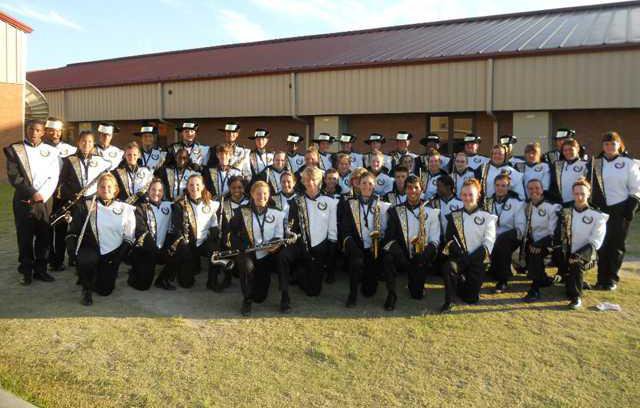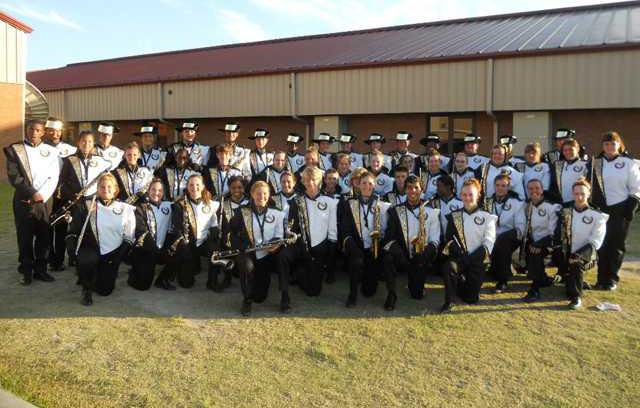When a marching band steps onto the field, in particular Richmond Hill High School’s Wildcat Marching Band, the show is not only entertaining but the obvious end result of countless hours of practice, learned music and strategic drill movements.
This year’s marching show is called “Perpetual Motion,” a competition show that depicts constant motion. This is a perfect fit for the Wildcats who are known for technically difficult music and drill and shows that keep them moving and playing throughout their whole performance.
The portrait of a marching band is sometimes misleading though, one imagines one big group. But actually, a marching band is a large group broken down into many sections or “parts.”
Each part perfects its own music within the larger group. Therefore, the marching spectators see on the field is the result of these smaller parts coming together to make one big sound.
A marching band’s anatomy is made up of many parts: brass, woodwinds, percussion/pit; and color guard. Each group brings something special and unique to the band.
The loudest and best known group in a marching band is the brass section. The Wildcat’s brass captain is Sean Hardy, with Hunter Odom leading the high brass and Mitchell Gramazio leading the low brass. Ethan Ruff is equipment captain.
High brass consists of trumpets and mellophones, and low brass boasts trombones, baritones and tubas. This section is considered by many to be the “heart and soul” of a marching band, producing the “volume” in the music necessary for the band to be heard in the stands. The brass section often gives a band its “wow” factor in a performance.
The woodwind section, consisting of clarinets, bass clarinets, saxophones and flutes, is led by woodwind captain Ruben Rios. Assisting are flute section leader Emma Morris, clarinet section leader Zaak Hinz, saxophone section leader Ashley Harkness, low winds section leader Andrea Wright and librarian Mallory McGee.
Although it’s a more silent group than their loud brass counterparts, the woodwinds fill in the softer portions of the show with a lighter sound. When the loud brass notes aren’t dominating, the woodwinds help listeners recognize and carry the melody of the song.
Next is the heartbeat of the band, better known as the percussion section. This year’s percussion captain is Jada McLeod. Drumline section leader is Darryl Dunham and pit section leader is Amberly Porter.
There are snare drums, bass drums and tenor drums. With every beat the drumline plays, the band plays a note and takes a step. The drumline is the rhythm of the band and keeps the marching in sync.
The pit is comprised of xylophones, cymbals, kettle drums, chimes, keyboard, bass guitar, etc. The pit is unique in that it gives the band’s music personality, or reflects the mood of the music. If the mood is soft, the pit instruments provide sounds for the show that are light and whimsical. If the music is strong, the pit can provide menacing sounds to charge the show. The pit gives the band creativity.
The next portion of the band doesn’t play instruments. Instead, they waves flags, twirl rifles, ribbons, stars or whatever the show demands. This group is called the color guard and is directed by Marlon Smith. This year’s student leaders are Kaylee Lawless, Jenai Polite and April Ward.
This group works as hard as the band, adding the “color” as named to the performances with their flags and props. They tell the story of the competition show with choreographed dances and drills.
And last but not least, is the part of the band that “leads” – the drum majors. This year’s drum majors are Kathryn Hester and Rich Li, and as such, they lay down their instruments and their hands become their baton.
All the band’s eyes are on the drum majors, seeking their direction at football games and competitions. And beyond the drum majors, the top spot for leadership goes to Dr. Daniel Kiene, leading the Wildcats this fall for his fifth year. Dr. Kiene, a teacher first and band director second, pulls the whole program together.
So what is the anatomy of the Wildcat Marching Band? Band parts coming together to produce one band, one sound and one winning season.
Go Wildcats!
Anatomy of RHHS Wildcats Marching Band


Sign up for our E-Newsletters